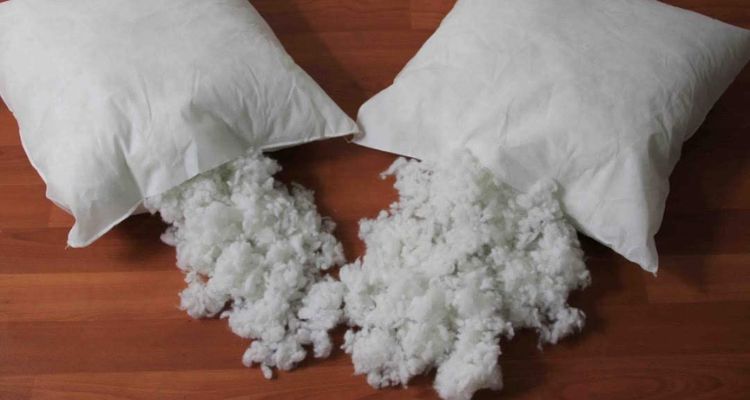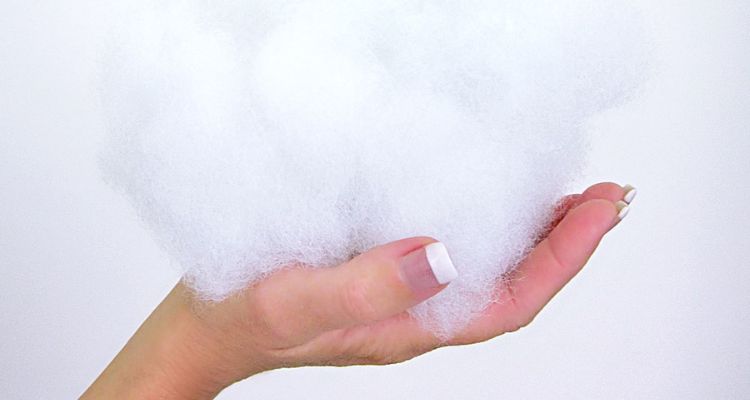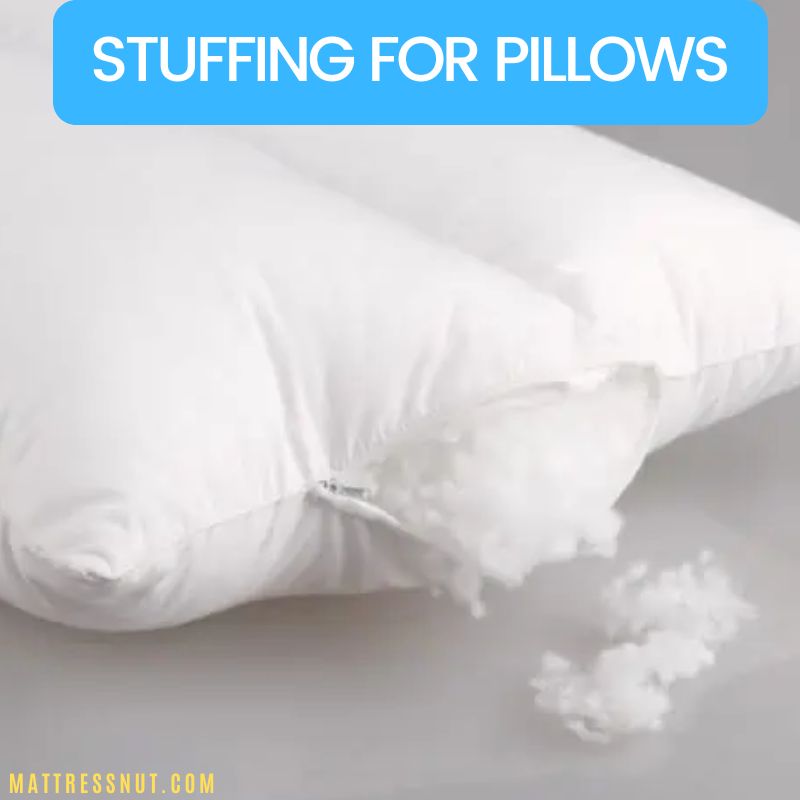A pillow is as important as a good mattress or other bedding items. The more comfortable, the better the sleep with better health. There are so many options out there. Therefore, choosing the best one is hard, especially with each offering its benefits and downsides. Similarly, not all pillows are suitable for everyone, as different people have different needs (check the top rated pillows for stomach sleepers). Therefore, we believe studying the different types of pillow stuffing in its manufacturing process is essential.
We believe the study below will help you understand these types to make the right decision for your pillow choice (also check the best selling pillows with great comfort).
Different Types of Pillow Stuffing

It’s challenging to tell which pillow will suit you best as there are too many options like latex, down stuffing, memory foam, feathers, etc (also check 8 amazing goose down pillows). Just like the outer portion, the inside filling is essential for the overall performance of your pillow.
For those who sleep hot, a pillow with a cooling technology feature must keep them cool throughout the night for healthy sleep (also check the top-quality cooling mattresses for hot sleeper). Check below for detail inside, and look into some of these different pillow stuffing types.
Down Pillow Stuffing
This pillow-filling fiber is made up of the bottom side of a goose or a duck. They look like a head of dandelion as their fibers create too soft clusters that look spherical. These fiber fillings are a bit expensive for bedding since they offer too many desirable features in one pillow. Its softness level makes you feel like you are sleeping on a cloud (also check 8 great fluffy pillows).
Due to this softness, they are primarily not only in pillows but in mattresses, mattress pads, and even other bedding products. In terms of durability, down naturally tends to maintain its three-dimensional shape; therefore, it does not collapse or become flat even after long usage.
It has excellent insulation; down fillings are warmer but breathable. Down is the most natural insulator in this pillow stuffing category. The down fillings are lightweight, which makes them more comfortable. These pillows can last for a life span of up to 15 years. It can adjust as needed as it can be molded enough.
These pillow fillings’ temperature regulation feature is excellent and changes according to the environment. It’s nearly impossible for you to find a 100% down pillow. However, you can settle for a proportion of 75% feathers with a 25% concerning down feathers.
Overall, these pillow fillings are one of the most luxurious and comfortable among the others available (also check the top rated luxury pillows).
Feather Pillow Stuffing
These pillow stuffing are the cheaper versions of down fillings. Feather stuffing is from the sheds that fell on the ground or were used as those ancient quill pens. Even though they are comfortable with a soft filling, they still come with some drawbacks due to their cheapness. The quills in them may poke you during use.
Comparative to down filling, they are flatter and have more chances of collapsing, ultimately will need more fluffiness to provide comfort. Their replacements would be sooner than down-filling pillows as they are not very durable due to low quality.
Some feather pillows are comparatively expensive than other feather-filling pillows. That is because they have small chunks and clusters of down fillings, but they are still not as effective as the down filling pillows.
On the other hand, their low features are cheaper while still giving a softer and fluffier comfort. It is popular among side and stomach sleepers since feather pillows are more accessible to fold around your neck and head (also check the top-quality pillows for side sleepers). These filling pillows were a great option in the past when materials were quite more expensive. So, if your budget is minimal, you can go with this option as overall, they are not that bad for an alternative option.
Memory Foam Pillow Stuffing
Memory foam pillows come with a mixture of small memory foam or a solid piece of memory foam inside. These fills have polyurethane chemicals and other materials, so this pillow can sink and has a thick and sticky feel. It can adjust with the sleeper’s head shape and return to its original position in a few seconds. It passes a strong odor with off-gassing that is very sensitive for some people.
Memory foam pillows are even dangerous for human health as they produce various chemicals. Some may not even have passed the GOTS and other safety organizations’ safety and comfort certification levels.
These stuffings are adaptable with a thick and sticky feel for good pressure points relief. They provide adequate support for all types of sleepers, regardless of their body size and weight (also check 10 great mattresses for overweight person). These fillings do not have a heat retaining feature and are not best for hot sleepers. A bit more expensive than other pillow fills with not that good performance factor.
Overall, memory foam pillow stuffing must be checked to pass the safety certifications for better health and comfort.
Polyester Fiberfill Pillow Stuffing
These pillows have synthetic fiber for pillows and other items like stuffed animals. Due to their acoustic properties, they are used in different audio speakers. Polyester stuffing, which is poly-fil or Polyfill, is small, curly fibers, and artificial. It is a highly affordable filling type and is suitable for indoor and outdoor uses.

Feel soft like a feather. They are quite light to carry and easy to clean. These pillows lose shape quickly and can flatten. However, these fillings are hazardous to health.
They are quite cheap and more affordable than those genuine filling pillows. For people who experience allergies from original down fillings, this Polyester fiberfill pillow stuffing can be a suitable option.
However, when it comes to durability, they are quite poor with a further downside as flattening, tending to lose their shape. Moreover, they have a warm feeling and are not for body heat users for their special needs.
Buckwheat Hulls Pillow Stuffing
Buckwheat hulls pillow stuffing comprises the outer part of Buckwheat Kernels. For their productions in pillows, only 5-10 pounds are used in each pillow filling. Unlike polyester fiber fillings, they are immaculate for their cooling and soothing features for head support.
Buckwheat Hull stuffing pillows are a good mixture of firmness and malleability. Therefore, they are suitable for people of all sleeping styles with good breathability support. These pillow fillings provide a good balance of body weight distribution. Consequently, they do not cause any pain due to pressure points (also check the best selling mattress toppers for pressure points).
These pillow stuffing have a good life span when you use them with care and wash them from time to time. Due to their moldable feature, they shift their shape accordingly and offer excellent head and neck support.
Buckwheat Hulls filling makes pillows flatten and do not collapse under your body during night sleep. Since these pillows have eco-friendly natural materials, they are safe and hygienic for all users. On their downside, they are a bit heavier than usual, averaging pillows with around 8 pounds in total.
Kapok Pillow Stuffing
Go with the name of ceiba pentandra, these trees are in Mexico, and their flowers are fluffy with a cotton-like feeling. They are sometimes called “silk cotton” due to their light-brown silk look.
This kapok stuffing is of natural fibers which are 100% natural and organic (check 8 amazing organic pillows). They are accessible for people with allergies due to the use of natural materials and fiber in their production. Finally, kapok fillings are an excellent alternative to down and polyester stuffing pillows due to their softness.
They are eco-friendly as they have started to use 100% natural and organic kapok filling materials and have avoided those polyurethane/polyester fillings. They are free of other toxic materials harmful to your skin and body. Their softness is higher than those down and foam filling pillows as they relatively have a soft texture.
However, to their downside, they are flammable and unsuitable for people with body heat issues. Like polyester filling foam, they get lumpy, cannot hold their shape, and flatten due to not being moldable.
Latex Pillow Stuffing
This pillow stuffing is becoming quite popular nowadays. They even give the cloud-softness feeling with excellent support for your neck and head. Unlike memory foam stuffed pillows, these pillows are malleable, and you can mold them easily. Furthermore, they do not flatten at all under your head. Therefore, they offer the best support and can conform with excellent softness when pressure is put on. These pillows are suitable for stomach and back sleepers (check the top rated pillows for back sleepers); however, they are an impeccable choice for side sleepers. These fillings have a slight smell when you open them, but it vanishes after some time.
Latex pillow fillings offer excellent breathability and help keep the body cool throughout the night’s sleep. However, unfortunately, it is not compatible with the level of breathability that Buckwheat Hull and Microbeads filling offer. They are eco-friendly and are free of hazardous chemicals and toxin materials.
However, they have a rubber-like smell that might feel too soft for some people, resulting in inconsistent support for their heads to be higher or lower than the required position.
Cotton Pillow Stuffing
Cotton pillow fillings are softer and compressing but firmer than down and polyfills. They offer breathability and comfort both in organic and raw form or can even be in mixed shredded polyester form. These cotton pillow stuffings make pillows soft to touch, easily workable, and naturally hypoallergenic.
All these features make them a safer option for people prone to allergies (also check the top mattresses for allergies). Compared to polyfills, they are a bit firm, making them a good choice for buyers looking for a reasonable item with good durability.
If the cotton is 100% natural and organic, these cotton filling pillows would be free of all harmful materials or substances, making them an excellent choice for safety-conscious people. Due to their excellent breathability, they are an ideal option for hot sleepers. People may even find it easier to sleep on because of its universal comfortability.
On their downside, they might work with all sleepers to some extent but are great for side sleepers. Their filling must be replaced more often than other pillow fillings. The cotton fibers can start clumping together over time, making them flatten and uncomfortable.
Which Filling Is Best for Pillows?
Down filling pillows are the best ones, especially the ones with Hungarian goose filling. They are most comfortable and soft, just like a feather, making you feel like you are sleeping on a cloud. In addition, they are moldable and adjust themselves as per your body shape, and do not flatten at all.
How Much Stuffing Do You Need for A Pillow?
It usually depends upon the size of a pillow. However, mostly 1-2 pounds of stuffing material is required for an average pillow.
What Can I Use to Stuff Throw Pillows?
Throw pillows are smaller and can be stuffed with fabric scrap, old clothes, or even yarn. For an excellent result, you can cut the fabric, turn it into small pieces, and then stuff them inside. However, these stuffing-made pillows are less fluffy than the ones with normal stuffings of other material types.
Key Takeaways
Importance of Pillow Fillings
A pillow’s comfort and support hinge significantly on its stuffing. Different fillings cater to different sleep needs and preferences. Thus, understanding the diverse stuffing options is pivotal to find the right pillow for optimal sleep.
The Varied Landscape of Pillow Stuffing
Pillow fillings vary widely, and each type offers distinct advantages:
- Down Pillow Stuffing: Derived from the underside of geese or ducks, down is plush, lightweight, and durable, often making it a luxury choice in bedding. It offers excellent insulation and can last up to 15 years.
- Feather Pillow Stuffing: While cheaper than down, feather stuffing tends to be less plush and can occasionally poke the user due to the quills. They’re malleable, making them suitable for side and stomach sleepers.
- Memory Foam Pillow Stuffing: Memory foam adjusts to the sleeper’s head shape, offering tailored support. However, it can sometimes emit a strong odor and may not be suitable for everyone.
- Polyester Fiberfill Pillow Stuffing: An affordable option, polyester-filled pillows are soft and hypoallergenic but might lose their shape quickly.
- Buckwheat Hulls Pillow Stuffing: These provide a blend of firmness and malleability, making them adaptable to various sleep styles. They also boast excellent breathability.
- Kapok Pillow Stuffing: Often termed as “silk cotton,” kapok stuffing is soft and eco-friendly, presenting a decent alternative to down and polyester stuffing.
- Latex Pillow Stuffing: Growing in popularity, latex pillows are malleable, supportive, and suitable for most sleepers, especially those who sleep hot.
- Cotton Pillow Stuffing: Cotton-filled pillows are soft, breathable, and hypoallergenic, making them a popular choice among many users.
Choosing the Right Pillow Filling
The best pillow filling largely depends on personal preference:
- For those seeking luxury and softness, down-filled pillows, especially those with Hungarian goose filling, are often favored.
- For those with allergies or seeking natural options, organic cotton or wool pillow stuffings can be an excellent choice.
- Budget-conscious consumers might lean towards polyester or feather stuffing, while those looking for firm support might consider memory foam or buckwheat hulls.
Maintaining and Adjusting Pillow Fillings
To ensure longevity and comfort, it’s essential to care for pillows appropriately:
- Regularly fluffing and adjusting the stuffing can help maintain the pillow’s shape.
- For those seeking added firmness, placing a heavy object on the pillow can help.
- It’s essential to check for signs of wear and replace or adjust stuffing as needed.
Conclusion:
Like the mattress, the pillow is a crucial part of your sleep; and the filling matters a lot. It does not sound easy to buy a pillow as many factors need to be considered before that. Price, comfort, body size and weight, and cover materials are the most thought.
However, we hope this study may have helped you understand the pillow fillings better and make the right choice considering your needs and wants. Overall, a pillow with 100% natural organic cotton is always recommended, which needs to be explored in the market before purchase.
Stuffing for pillows FAQs
What Is the Healthiest Pillow Filling?
Looking for a firm and healthy pillow, your first preference is 100% natural wool or cotton pillow stuffings. These stuffings are hypoallergenic and safe against dust mites and bacteria. It even refrains you from itchiness, rashes, or trouble with breathing as they provide excellent breathability.
How Do You Make Pillow Stuffing?
You can cut the small pieces of leftover scrap fabrics into small pieces around 1-inch; next, you can cut the clothing items like towels or linens, no larger than 1 inch.
Use an old foam mattress or a couch cushion, all using scissors into small chunks that should be around half an inch. Put some pieces of fabric into the mattress pad and blow air in it. Next, put all parts of fabric and clothing into that pad and mix them well for a new pillow filling.
How Can I Make My Pillow Firmer?
To make a pillow firm than it already is, you can put a little heavy object on its top. For example, a large or heavy book, a small yet heavy box, or even a couple of bricks wrapped in a towel can be put on the pillow to make it more firm than normal.
How Do You Stuff A Pillow Without Lumps?
Turn outside, right the pillow's fabric, and keep it open a few inches at one end. Again, turn it outside from the right. Take out some polyester fiberfill; tear them apart to end the fluffiness. Incorporate the fiberfill by packing it into the pillow's farthest corners.
Take out fiberfill pieces of the same size and consistency. Keep going until the pillow is filled. Start sewing the pillow's open edges and squeeze it hard until the fiberfill fully scatters around all over it on the inside.
Why Does My Pillow Go Flat?
The common reason is that your head may press around its soft part for a long time. This can make your pillow flat by losing its fluffiness. Another factor could be moisture.

